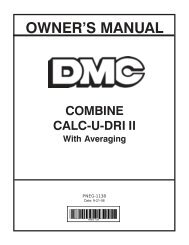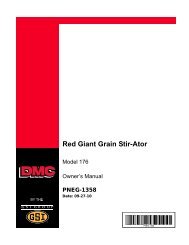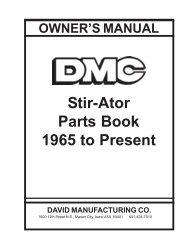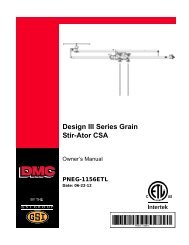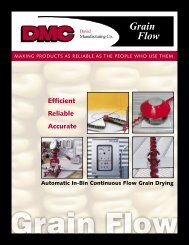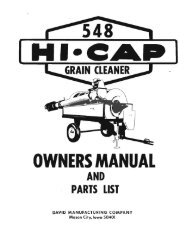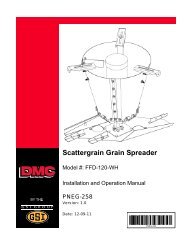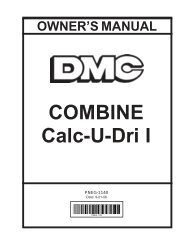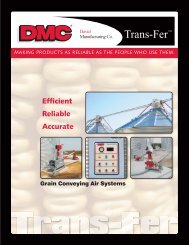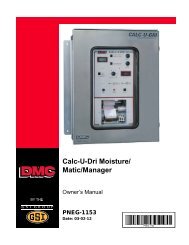PNEG-1162CEX - DMC DIII Stir-Ator - David Manufacturing Co.
PNEG-1162CEX - DMC DIII Stir-Ator - David Manufacturing Co.
PNEG-1162CEX - DMC DIII Stir-Ator - David Manufacturing Co.
You also want an ePaper? Increase the reach of your titles
YUMPU automatically turns print PDFs into web optimized ePapers that Google loves.
<strong>DMC</strong> <strong>DIII</strong> <strong>Stir</strong>-<strong>Ator</strong>Owner’s Manual<strong>PNEG</strong>-<strong>1162CEX</strong>Date: 08-29-12<strong>PNEG</strong>-<strong>1162CEX</strong>
CE Declaration EC Machinery Directive 98/37/EC Atex Directive 94/9/ECGSI Group1004 E. Illinois St.Assumption, IL. 62510Phone: 217-226-4421The GSI Group declares that the machine, parts or equipment.<strong>DMC</strong> <strong>Stir</strong>-<strong>Ator</strong>sModelso CEX, 1 auger, 2 auger and 3 auger models.Meets the essential requirements of the Machinery Directive 98/37/EC and has been assessed andconstructed to meet the requirements of the Atex Directive 94/9/EC Category Classification Ex II 2 Din accordance with the following harmonized standards:EB60204-1:1997; EN292:1991; EN294:1992; EN50014:1998; EN1127-1:1998; EN50281-11:1999;EN13463-1 and -5:2001EN60204-1:1997; EN292:1991; EN294:1992The equipment above must not be put into service until the machinery into which it is to be incorporatedhas been declared in conformity with the provisions of all relevant directives or until these componentshave been assembled in the manner recommended in the manufacturers instructions.Signed : F.G.WardRelease Date : 1 May 2006Review Date : 1 May 2009Name : F. G. Ward BSc; MPhil; CEng; MIAgEPosition : GSI <strong>Co</strong>mpliance Engineer being the responsible person appointed by the manufacturer.2 <strong>PNEG</strong>-<strong>1162CEX</strong> <strong>DMC</strong> <strong>DIII</strong> <strong>Stir</strong>-<strong>Ator</strong>
Table of <strong>Co</strong>ntents<strong>Co</strong>ntentsChapter 1 Safety ..................................................................................................................................................... 4Maintenance .......................................................................................................................................... 4Installation ............................................................................................................................................. 5Operation .............................................................................................................................................. 5Chapter 2 Safety Decals ........................................................................................................................................ 6Chapter 3 Bin Loading ........................................................................................................................................... 7Chapter 4 <strong>Stir</strong>-<strong>Ator</strong> Specifications ....................................................................................................................... 8Chapter 5 Installation ............................................................................................................................................ 9Track ..................................................................................................................................................... 9Suspension Chain Installation ............................................................................................................. 10<strong>Stir</strong>rer Assembly .................................................................................................................................. 12Wiring .................................................................................................................................................. 21Chapter 6 Start-Up ............................................................................................................................................... 34Start-Up in a Full Bin ........................................................................................................................... 34Chapter 7 Warranty .............................................................................................................................................. 35<strong>PNEG</strong>-<strong>1162CEX</strong> <strong>DMC</strong> <strong>DIII</strong> <strong>Stir</strong>-<strong>Ator</strong> 3
1. SafetyMaintenanceDANGERWhen working on or around the <strong>Stir</strong>-<strong>Ator</strong>, it is essential that a safe system ofwork is strictly followed. Failure to do so may result in serious injury to theoperator. Before carrying out any work on the <strong>Stir</strong>-<strong>Ator</strong>.1. Stop the <strong>Stir</strong>-<strong>Ator</strong> and all other machines BEFORE entering the bin.2. Ensure the isolator switch is locked into the “OFF” position, with the only key in the possession.3. Due to the height of the <strong>Stir</strong>-<strong>Ator</strong> in a bin, it is recommended that routine maintenance be carried outwith the bin full, working off boards laid on top of the grain.4. If access to the <strong>Stir</strong>-<strong>Ator</strong> is required when the bin is completely or partly empty, a safe means ofaccess must be used, preferably using a working platform.5. If using a ladder, DO NOT place the ladder against the <strong>Stir</strong>-<strong>Ator</strong> carriage unless it has been securelyclamped on either side to prevent movement. Failure to do this could cause a fatal accident. Notethat drying floors in grain stores may be slippery and therefore the ladder should be securely fixedbefore attempting to gain access.6. When setting a ladder against the <strong>Stir</strong>-<strong>Ator</strong>, a vise grip or some type of tie-down should be used inthe front and back of the track drive unit. This keeps the <strong>Stir</strong>-<strong>Ator</strong> from rolling or sliding around thebin while service work is being performed.7. If an unusual amount of service work is to be performed on a <strong>Stir</strong>-<strong>Ator</strong>, removing the augers andlowering the unit to the floor of the bin may be the safest way to repair the unit.8. Caution needs to be exercised when using a ladder to perform service work in a partially filled grainbin. The ladder can sink into the grain causing it to fall.9. Notice of noise and dust hazard: The <strong>Stir</strong>-<strong>Ator</strong> runs at noise levels below 70 db and should notpresent any risk to hearing. Decals indicating the possibility of dust are provided in the owner’smanual bag and should be installed per the diagram shown on Page 6. Dust may be created as anormal part of the stirring function of the <strong>Stir</strong>-<strong>Ator</strong> augers and although no person should be in thebin during the stirring operation, some residual dust may remain in the air after the <strong>Stir</strong>-<strong>Ator</strong> has beenturned “OFF”. The level of dust will vary depending on the condition of the grain. Operator’s shouldassess the risk to themselves and others, as required in the EU under the <strong>Co</strong>ntrol of SubstancesHazardous to Health Regulations. They should then implement appropriate control measures toreduce the risks to health.10. If attending to stuck augers, NEVER attempt to release the auger without isolating the <strong>Stir</strong>-<strong>Ator</strong> first.11. Before restarting the <strong>Stir</strong>-<strong>Ator</strong>, ensure that there is no one remaining in the bin and that the bin accessdoor is locked/closed.12. Remember to replace all guards before restarting.4 <strong>PNEG</strong>-<strong>1162CEX</strong> <strong>DMC</strong> <strong>DIII</strong> <strong>Stir</strong>-<strong>Ator</strong>
Installation1. The correct installation procedure is outlined in this manual.1. Safety2. Always install all recommended safety devices, such as safety isolators, grain level switches anddoor isolators. Failure to do so is a misuse of the equipment and may result in unsafe operation.3. Always use the recommended flexible cable (type HO7). Failure to do so may result in damage tothe electrical cable and risk electrical shock.4. All electrical wiring should be in accordance to EN60204:1998.5. All electrical installation must be carried out by a suitably qualified electrical engineer.6. The system and all associated steel work must be safely earthed.Operation1. Read and understand the owner’s manual.2. Keep all safety shields in place.3. Prior to inspecting, servicing, lubricating or adjusting the <strong>Stir</strong>-<strong>Ator</strong>, ensure the isolator switch is lockedin the “OFF” position, with the only key in the possession.4. Do not operate the <strong>Stir</strong>-<strong>Ator</strong> unless shut off chain has been properly installed and adjusted.5. NEVER enter the bin while the <strong>Stir</strong>-<strong>Ator</strong> is in operation.6. In the event that an auger becomes bound, the system should be switched OFF, isolated and lockedOFF before any attempt to release the auger.7. Operating the <strong>Stir</strong>-<strong>Ator</strong> during bin unloading can be beneficial to the unloading process as well asprevent auger damage.8. DO NOT OVER FILL THE GRAIN BIN. BURYING THE STIRRER WILL DAMAGE BIN AND WILLVOID THE DESIGN III WARRANTY.9. DO NOT OPERATE DESIGN III STIR-ATOR IN AN EMPTY BIN.<strong>PNEG</strong>-<strong>1162CEX</strong> <strong>DMC</strong> <strong>DIII</strong> <strong>Stir</strong>-<strong>Ator</strong> 5
2. Safety DecalsCheck that all safety decals are in place. If damaged or unreadable, please request a replacement.DC:889Both sides of swivelbox plus junctionbox cover.DC:1386Top of gear motor track frame.WARNINGSHEAR POINTMoving parts cancrush and cut. Keephands clear ofsprocket and chain.DC-13861067021Both sides of bottom motormounting rail in trolley andboth sides of optional offset.KEEP CLEAR OF ROTATING PARTS.1067021Machinery in this bin operates underautomatic control and may startwithout any warning.AIRBORNE PARTICLES MAY BEPRESENT DURING AND AFTEROPERATION. MAY IMPAIR VISIONAND BREATHING.1067023Do not enter the bin unless the mainpower isolator is locked in the “OFF”position and the only key is in yourpossession. Check that power to allequipment is “OFF” before entering.Failure to do so may result in afatal accident.10670206 <strong>PNEG</strong>-<strong>1162CEX</strong> <strong>DMC</strong> <strong>DIII</strong> <strong>Stir</strong>-<strong>Ator</strong>
3. Bin LoadingUser’s must be aware that the <strong>Stir</strong>-<strong>Ator</strong> will impose significant load on the bin structure. It is essential toensure that the structure is capable of withstanding these loads:<strong>Stir</strong>rer System Weights(Includes 1.5 Kw (2 HP), 3 Phase Motors)Bin SizeTriple Auger18' (5.5 m) -21' (6.4 m) 415 Kg24' (7.3 m) 432 Kg27' (8.2 m) 453 Kg30' (9.1 m) 477 Kg33' (10.1 m) 497 Kg36' (11.0 m) 526 Kg42' (12.8 m) 567 Kg48' (14.6 m) 608 KgAdditional Weight due to Augers16' (4.9 m) Augers 27 Kg per Auger18' (5.5 m) Augers 31 Kg per Auger20' (6.1 m) Augers 34 Kg per Auger22' (6.7 m) Augers 37 Kg per AugerThrust due to Auger OperationAuger ThrustInitial Start-Up - Wet Grain16' (4.9 m) Auger 14' (4.3 m) Grain 167 Kg per Auger18' (5.5 m) Auger 16' (4.9 m) Grain 177 Kg per Auger20' (6.1 m) Auger 18' (5.5 m) Grain 186 Kg per AugerAuger ThrustNormal Operation - Wet Grain16' (4.9 m) Auger 14' (4.3 m) Grain 94 Kg per Auger18' (5.5 m) Auger 16' (4.9 m) Grain 109 Kg per Auger20' (6.1 m) Auger 18' (5.5 m) Grain 136 Kg per Auger<strong>PNEG</strong>-<strong>1162CEX</strong> <strong>DMC</strong> <strong>DIII</strong> <strong>Stir</strong>-<strong>Ator</strong> 7
4. <strong>Stir</strong>-<strong>Ator</strong> SpecificationsSection to be added8 <strong>PNEG</strong>-<strong>1162CEX</strong> <strong>DMC</strong> <strong>DIII</strong> <strong>Stir</strong>-<strong>Ator</strong>
5. InstallationGSI RECOMMENDS THAT YOU REFER TO THE GRAIN BIN INSTALLATION/USAGE MANUAL,BEFORE INSTALLING THE STIR-ATOR, TO CHECK FOR ANY ADDITIONAL REQUIREMENTS FORTHE BIN TO CARRY THE STIRRING AUGER SYSTEM.On a new bin installation, we recommend the stirrers be installed as the bin is assembled, allowing muchof the work to be carried out at ground level.Where stirrers are being retrofitted into existing bins, suitable access and lifting gear will be required insidethe bin.Track1. Track must be installed at the correct level below eaves to ensure the stirrer does not foul the roof orother objects in the bin. See Figure 5F on Page 11 for recommended minimum dimensions.2. NOTE: Internal ladders must be removed before installing stirrers.3. Mark the correct height and drill an 8 mm hole. Note aim to drill on the top of the corrugation ratherthan bottom to ensure the bracket fixes level.4. Using the connector plate (A) and track bracket (B) as a template, drill a second 8 mm hole.Figure 5A Track Installation5. Start with the end of the track pre-drilled with two (2) holes. Fix the track through the bracketand wall.6. Using the hole in the track and bracket as a guide, drill the next hole and install an additional trackbracket and bolt, repeating this procedure around the bin. (See Figure 5A and Figure 5B.)Figure 5B Drill 8 mm Holes<strong>PNEG</strong>-<strong>1162CEX</strong> <strong>DMC</strong> <strong>DIII</strong> <strong>Stir</strong>-<strong>Ator</strong> 9
5. Installation7. The final piece track will need to be cut and drilled to butt up to the first. Ensure no rough edges areleft and that the track is level and even all around the bin. (See Figure 5C.)Figure 5C Cut Final Piece to Fit8. Any long bin bolts adjacent to the track should be cut back or reversed to ensure they do not foul thetrack wheels when fitted. (See Figure 5D.)Suspension Chain InstallationFigure 5D Check clearance between long bin bolts.Suspension chains can now be lowered through the roof centre hatch.1. Space the suspension hooks equally apart around the center fill-hole collar. Note position in relationto the safety shut off switch (to be fitted later). (See Figure 5E on Page 11.)2. Lock the hooks in position using the holes provided.3. Note, if a safety switch and line is to be installed (NOT SUPPLIED), recommended locations are asshown below.10 <strong>PNEG</strong>-<strong>1162CEX</strong> <strong>DMC</strong> <strong>DIII</strong> <strong>Stir</strong>-<strong>Ator</strong>
5. InstallationFigure 5E Suspension Bar and Chain LocationsFigure 5F Typical Safety Switch Installation<strong>PNEG</strong>-<strong>1162CEX</strong> <strong>DMC</strong> <strong>DIII</strong> <strong>Stir</strong>-<strong>Ator</strong> 11
5. Installation<strong>Stir</strong>rer Assembly1. Separate the two (2) rails and place them on two (2) saw horses and remove the two (2) bolts holdingthe frame rails together, spacing them approximately 200 mm apart. (See Figure 5G.)Figure 5G Place <strong>Stir</strong>rer Rails2. Fit the outboard frame end using six (6) carriage bolts, nuts and lock washers. Ensure the boltheads are inside the rails. Ensure the marking 1-1/2" is uppermost when fitting the frame end.(See Figure 5H.)3. Attach the track drive unit. (See Figure 5I.)Figure 5H Fit Outboard Frame EndsTrack drive unitCarriageboltsFigure 5I Track Drive Unit12 <strong>PNEG</strong>-<strong>1162CEX</strong> <strong>DMC</strong> <strong>DIII</strong> <strong>Stir</strong>-<strong>Ator</strong>
5. Installation4. NOTE: Augers used in 11 m or wider grain bins require the trolley hold-down rods to be moved tothe bottom hole position. This is done by removing the cotter pin and pulling the rod out andreinserting it in the bottom holes. Refer to Figure 5J and Figure 5K.Hold-downrod holesFigure 5J Auger TrolleyHold-down rodFigure 5K Trolley Hold-Down Rod5. Place the auger trolley onto the frame, as shown in Figure 5L on Page 14. Check the orientationof the trolley in relation to the track drive unit and bin wall.6. Fit the auger trolley drive post and arm, using the lower hole in the post and two (2) cotter pins(one below, one above the trolley) provided.<strong>PNEG</strong>-<strong>1162CEX</strong> <strong>DMC</strong> <strong>DIII</strong> <strong>Stir</strong>-<strong>Ator</strong> 13
5. InstallationAuger trolleydrive armAuger trolleydrive postTowards bin wallFigure 5L Mount Trolley on Frame RailsFigure 5M Fit Auger Trolley Drive Post and Arm (Use lower holes.)7. Now bolt the inboard (bin centre) frame end onto the rails, using the carriage bolts provided.(See Figure 5N.)Figure 5N Fit Inboard (Bin Centre) Frame End8. Check that the hold-down rods are positioned correctly. There should be approximately 10 mmbetween the rod and the bottom of the rail. (See Figure 5O on Page 15.)14 <strong>PNEG</strong>-<strong>1162CEX</strong> <strong>DMC</strong> <strong>DIII</strong> <strong>Stir</strong>-<strong>Ator</strong>
5. Installation10 mmFigure 5O <strong>Co</strong>rrect Hold-Down Rod Position9. The yoke assembly is attached to the frame rails by placing the pivot tube into the center framesupport. Secure by placing a cotter pin through the tube. (See Figure 5P and Figure 5Q.)Figure 5P Centre Yoke AssemblyFrame inboard endCentre yoke pivot tubeFigure 5Q Centre Yoke Pivot<strong>Co</strong>tter pin<strong>PNEG</strong>-<strong>1162CEX</strong> <strong>DMC</strong> <strong>DIII</strong> <strong>Stir</strong>-<strong>Ator</strong> 15
5. Installation10. The end yoke is bolted to the left frame rail with two (2) 3/8" x 1" carriage bolts, lock washers and hexnuts. Bolt heads must be inside the rails to prevent interference with the trolley. (See Figure 5R andFigure 5S.)Figure 5R End YokeFigure 5S Fit End Yoke11. Attach the end yoke to the main tube as shown in Figure 5T.Figure 5T Fit End Yoke to Tube16 <strong>PNEG</strong>-<strong>1162CEX</strong> <strong>DMC</strong> <strong>DIII</strong> <strong>Stir</strong>-<strong>Ator</strong>
5. Installation12. NOTE: 36' and larger units have an additional center support yoke. Attach the top end of the supportyoke to the center extension tube using a 1-3/4" spacer tube, one 3/8" x 2-1/2" hex head bolt and hexlock nut. Locate approximately 4" from wire support swing arm toward outboard end side. Placebottom of support yoke onto the frame rail angle flange and fasten with 3/8" x 1" set screw.(See Figure 5U and Figure 5V.)Figure 5U Fit Intermediate Yoke and Cable Swing ArmFigure 5V Attach Yoke to Steel Angle13. Attach the slip ring unit to the centre yoke assembly using a 1/2" x 3" bolt, lock nut and roll pin asshown in Figure 5X on Page 18.Figure 5W Slip Ring Unit<strong>PNEG</strong>-<strong>1162CEX</strong> <strong>DMC</strong> <strong>DIII</strong> <strong>Stir</strong>-<strong>Ator</strong> 17
5. Installation1/2" x 3" Boltand lock nutRoll pinFigure 5X Fit Slip Ring Unit14. Attach the slip ring anchor plate as shown in Figure 5Y.Anchor plateBoltFigure 5Y Fix Slip Ring Anchor Plate18 <strong>PNEG</strong>-<strong>1162CEX</strong> <strong>DMC</strong> <strong>DIII</strong> <strong>Stir</strong>-<strong>Ator</strong>
5. Installation15. Attach the slip ring top shaft support bracket, as shown in Figure 5Z.Bracket1/2" Grade 8bolt, lock nutand washerSlip ringFigure 5Z Fix Top Shaft Bracket16. Attach the beam box mount plate to the trolley as shown in Figure 5AA. Use four (4) 1/4" x 5/8" flangewhiz lock screws and nuts. Check the plate is the correct way up, as shown.Mount plateBolt andnut (4)Figure 5AA Fix Beam Box Mounting Plate<strong>PNEG</strong>-<strong>1162CEX</strong> <strong>DMC</strong> <strong>DIII</strong> <strong>Stir</strong>-<strong>Ator</strong> 19
5. Installation17. Attach the cable support arm as shown in Figure 5AB. Use two (2) 1/4" x 5/8" flange whiz lock screwsand nuts. Check the plate is the correct way up, as shown.Support armBolt andnut (2)Mount plateFigure 5AB Fix Cable Support Arm18. Attach the beam box to the mounting plate with the cable glands uppermost. Use four (4) 5 mmself-tapping screws. (See Figure 5AC.)Figure 5AC Beam Box20 <strong>PNEG</strong>-<strong>1162CEX</strong> <strong>DMC</strong> <strong>DIII</strong> <strong>Stir</strong>-<strong>Ator</strong>
5. InstallationCable glandsBeam boxFigure 5AD Mount Beam Box on PlateThe unit is now ready for initial wiring. It is important that this is done before attaching the drive armto the drive wire so that the cable lengths can be checked to ensure the trolley can move freely.WiringCable RoutingNOTE: <strong>Co</strong>rrect cable must be used, as approved for use on mobile machinery. See the table for thecorrect cable types for the installation.<strong>Co</strong>nductor sizes given are minimum. The installing electrician must calculate the cable size required tosuit site conditions and to comply with relevant wiring and electrical regulations and codes.Figure 5AE General Wiring Scheme<strong>PNEG</strong>-<strong>1162CEX</strong> <strong>DMC</strong> <strong>DIII</strong> <strong>Stir</strong>-<strong>Ator</strong> 21
5. InstallationMinimum Cable RequirementsMain CurrentProtectionSupply toSlip Ring *Slip Ring toBeam BoxBeam Box toAuger MotorBeam Box toTrack MotorTwin Auger,3 PhaseFuse3 x 25A6 mm²6 <strong>Co</strong>re H074 mm²5 <strong>Co</strong>re H071.5 mm²4 <strong>Co</strong>re H071.5 mm²3 <strong>Co</strong>re H07Triple Auger,3 PhaseFuse 3 x 33 x 32A6 mm²6 <strong>Co</strong>re H076 mm²5 <strong>Co</strong>re H071.5 mm²4 <strong>Co</strong>re H071.5 mm²3 <strong>Co</strong>re H07Twin Auger,1 PhaseFuse2 x 25A6 mm²6 <strong>Co</strong>re H076 mm²5 <strong>Co</strong>re H072.5 mm²3 <strong>Co</strong>re H071.5 mm²3 <strong>Co</strong>re H07Triple Auger,1 PhaseMotor ProtectionUnit 32A6 mm²6 <strong>Co</strong>re H076 mm²5 <strong>Co</strong>re H072.5 mm²3 <strong>Co</strong>re H071.5 mm²3 <strong>Co</strong>re H07* Note, sixth core carries 230 VAC signal for ‘<strong>Stir</strong> Guard’.1. Run a five (5) core cable, as shown in Figure 5AF below, Figure 5AG on Page 23 and Figure 5AHon Page 23, from the slip ring junction box to the beam box, running through the openings given andover the cable arms.2. BEFORE CUTTING TO LENGTH, CHECK THERE IS SUFFICIENT LENGTH TO PREVENTDAMAGE AS THE TROLLER MOVES UP AND DOWN THE BEAM.3. CHECK THAT THE LOOP OF CABLE DOES NOT FOUL ON ANY PARTS OF THE STIRRER.5 <strong>Co</strong>re H07 cableFigure 5AF Cable Route in Centre Yoke22 <strong>PNEG</strong>-<strong>1162CEX</strong> <strong>DMC</strong> <strong>DIII</strong> <strong>Stir</strong>-<strong>Ator</strong>
5. Installation5 <strong>Co</strong>re H07 cableFigure 5AG Cable Route Out of TubeCable gland5 <strong>Co</strong>re H07 cableBeam box4. Use wire ties to tie the cable to the cable arms.Figure 5AH Cable Route into Beam Box5. Run a cable from the beam box to the auger motors as shown in Figure 5AG.3 or 4 <strong>Co</strong>reH07 cableAuger motorcable glandFigure 5AI Cable Route to Auger Motor<strong>PNEG</strong>-<strong>1162CEX</strong> <strong>DMC</strong> <strong>DIII</strong> <strong>Stir</strong>-<strong>Ator</strong> 23
5. Installation6. Run a cable from the beam box to the track motor, as shown in Figure 5AI on Page 23 andFigure 5AJ, attaching to the cable arms and end yoke with wire ties.3 <strong>Co</strong>reH07 cableFigure 5AJ Track Motor CableElectrical <strong>Co</strong>nnectionsFigure 5AK Track Motor CableMake connections in accordance with connection diagrams in Figure 5AL and Figure 5AM on Page 25.NOTE on 1 phase units, two (2) parallel LIVE and two (2) parallel NEUTRAL supplies must be used.24 <strong>PNEG</strong>-<strong>1162CEX</strong> <strong>DMC</strong> <strong>DIII</strong> <strong>Stir</strong>-<strong>Ator</strong>
5. InstallationNOTE: Installer must ensure continuity oflow impedance protective earth circuit to allconductive surfaces and electrical equipment.Figure 5AL Slip Ring <strong>Co</strong>nnections - 3 Phase UnitsFigure 5AM Beam Box Wiring - 3 Phase Triple Auger UnitsBEFORE PUTTING INTO SERVICE, THE INSTALLER MUST CHECK THAT ALL CABLE GLANDS ANDSTRAIN RELIEFS ARE FULLY TIGHTENED.<strong>PNEG</strong>-<strong>1162CEX</strong> <strong>DMC</strong> <strong>DIII</strong> <strong>Stir</strong>-<strong>Ator</strong> 25
5. InstallationTrolley Drive AssemblyRun the trolley drive wire around the centre drive pulley and end idler pulleys, as shown in Figure 5AN.Idler pulleyTrolley drive wireDrive pulleyFigure 5AN Drive Wire Attachment<strong>Co</strong>nnect trolley drive arm to cable connector using one 1/2" SAE flat washer and 5/32" x 1" cotter pin.(See Figure 5AO.) BE SURE CABLE CONNECTOR IS AS SHOWN IN PHOTO. If assembled incorrectly,connector will not go around cable pulleys.Figure 5AO Drive Wire AttachmentFigure 5AP <strong>Co</strong>rrect <strong>Co</strong>nnector Alignment26 <strong>PNEG</strong>-<strong>1162CEX</strong> <strong>DMC</strong> <strong>DIII</strong> <strong>Stir</strong>-<strong>Ator</strong>
5. InstallationCentre Suspension AssemblyThe triple auger units use a “T” shaped suspension bar, whilst double auger units use a straight bar.7. Assemble the “T” piece. (See Figure 5AQ.) (Straight suspension bar requires no assembly.)Figure 5AQ Assemble “T” Suspension Bar8. Slide the attachment link over the suspension bar and fix it to the upper shaft bracket on the slip ring,using a grade 8, 1/2" x 2" bolt, lock nut and washer. (See Figure 5AR.)Double augersuspension barAttachment linkLifting <strong>Stir</strong>rer into PositionThe stirrer is now ready to hoist into position.Figure 5AR Attach Suspension Bar9. Use a suitable lifting block and tackle or other device, lifting from the centre of the suspension barand track motor end simultaneously.10. Before lifting, move the auger trolley towards the centre of the bin and clamp it in place to stop itrolling backwards and forwards.11. When the suspension bar is about 450 mm above the eave height, the ends of the suspension chainsshould be placed through loops and around the tube ends and hooked back on the main strand withthe “S” hooks. (See Figure 5AS on Page 28.)<strong>PNEG</strong>-<strong>1162CEX</strong> <strong>DMC</strong> <strong>DIII</strong> <strong>Stir</strong>-<strong>Ator</strong> 27
5. Installation12. <strong>Stir</strong>-<strong>Ator</strong> height can be adjusted at the chains.Figure 5AS Assemble Suspension Chains13. Lift the track unit onto the bin wall track. Install the two (2) track hold-down pins with the pinheads located directly under the lower track edge, secure with two (2) 5/32" x 1" cotter pins.(See Figure 5AT and Figure 5AU.)Figure 5AT Lift Track Drive onto RailsFigure 5AU Fit Hold-down Pins14. To prevent the stirrer from moving on the rails we recommend locking it in place with vise grips.(See Figure 5AV on Page 29.)28 <strong>PNEG</strong>-<strong>1162CEX</strong> <strong>DMC</strong> <strong>DIII</strong> <strong>Stir</strong>-<strong>Ator</strong>
5. InstallationFigure 5AV Lock Unit with Vise Grips15. Now position the centre of the stirrer so that it is higher than the track drive unit. Refer to the tablebelow for the correct height difference for the bin diameter.Bin DiameterUp to 18' (5.5 m)Up to 27' (8.2 m)Up to 36' (11.0 m)Over 36' (11.0 m)Height Difference between Centre and Side25 mm40 mm55 mm70 mm<strong>Co</strong>nnection to Power SupplyWARNINGIt is essential that the <strong>Stir</strong>-<strong>Ator</strong> is supplied via a safety isolator located at theeaves hatch of the bin. This must be rated to IP 65 minimum and have a currentrating no less than 32 amps. The switch must also be lockable.DANGERWARNINGOnce the auger is installed into a grain bin, the bin becomes a hazardousenvironment. No-one must ever be in the bin when the auger is operating.GSI recommends the installation of safety switches on the personnel door sothat whenever the door is opened all equipment stops automatically and cannotbe restarted without the door first being closed and the operator restarting atthe main control panel.WARNINGDANGERGSI recommends the installation of suitable emergency stops to stop allequipment within the bin in the event of an emergency.This is the responsibility of the installer and a requirement under the CEdirectives to which this installation must comply. Failure to do so can endangerlife and will invalidate any warranties and guarantees.<strong>PNEG</strong>-<strong>1162CEX</strong> <strong>DMC</strong> <strong>DIII</strong> <strong>Stir</strong>-<strong>Ator</strong> 29
5. Installation1. Refer to connection diagrams on Page 25, run a H07, 6 core cable from a safety shut off switch atthe eaves hatch to the slip ring.2. Make the correct connections on the ‘Harting’ plug provided, ensuring that pin number 6 is reservedfor the stir guard signal where this is used.3. Power should be brought to the isolator switch via a main control panel (not supplied), which mustinclude the correct over current protection and motor contactors for the <strong>Stir</strong>-<strong>Ator</strong>.4. Tie the supply cable safely to a cable tray fitted inside the roof of the bin so that the cable is notvulnerable to mechanical damage.5. At this stage it is advisable to carry out a rotation test to ensure the augers motors and track motorsare running in the correct direction. When viewed from the TOP the augers should turn clockwise.When running around the bin wall, the whole <strong>Stir</strong>-<strong>Ator</strong> should rotate in a clockwise manner whenviewed from above.6. ONCE THE ROTATION CHECK IS COMPLETE THE POWER SHOULD BE DISCONNECTED ANDLOCKED OFF.<strong>Stir</strong> Guard1. <strong>Stir</strong> guard is a safety timer system designed to shut off the augers in the event that the track unit isunable to move the <strong>Stir</strong>-<strong>Ator</strong> around the bin. This prevents damage to the grain.2. The slip ring unit is equipped with a built in switch connected to pin 6 in the ‘Harting’ connector.As the stirrer progresses around the bin, the switch will make and break a 230 VAC signal. Byconnecting this to a timer in the main control panel, you can cause the <strong>Stir</strong>-<strong>Ator</strong> to shut down if the230 VAC signal has not been received after a pre-set time. Recommended minimum timer settingsare given in the table below.Bin DiameterMinimum Timer SettingInstall Augers18' (5.5 m) 25 Min.27' (8.2 m) 35 Min.36' (11.0 m) 45 Min.48' (14.6 m) 60 Min.1. The stirrer auger may need to be cut to length so that it hangs at least 75 mm above the highest pointon the floor of the grain bin.2. In a bin with no sweep auger and just a flat floor, the highest point must be taken as the floorimmediately adjacent to the bin wall.3. If the bin is fitted with any sweep or floor augers, auger must be measured from the highest part ofthe floor auger.4. To measure the auger rod length, position the trolley directly above the highest point, insert a tapeinto the auger stub shaft and measure to the highest point. Remove 75 mm from this height to getthe required auger length.5. Measure the length on the auger rod and cut to length. ONLY CUT FROM THE BOTTOM OF THEAUGER. NEVER FROM THE TOP.30 <strong>PNEG</strong>-<strong>1162CEX</strong> <strong>DMC</strong> <strong>DIII</strong> <strong>Stir</strong>-<strong>Ator</strong>
5. Installation6. Use a small grinder to remove any burrs from the cut edge.7. To prevent the auger flight from coming away at the cut end the flight should be welded to the rodusing 20 mm tack welds, starting at the end of the flight and rod and in 2 further positions within thefirst pitch of flight. (See Figure 5AW.)NEVER WELD ANY FURTHER UP THE AUGER AS THIS CAN RESULT IN AUGER WEAKENING ANDSUBSEQUENT BREAKAGE.NEVER ATTEMPT TO EXTEND AND AUGER BY ADDING ADDITIONAL PIECES.WeldpositionsFigure 5AW Weld Flight on Cut End8. Drill a 8 mm diameter hole about 8 mm deep into the auger shaft, 38 mm from the top.(See Figure 5AX.)Figure 5AX Auger Shaft Drilling9. Slide the auger into the stub shaft and align the holes in the stub shaft and auger shaft.10. Place the auger clamp with spring pin over the holes so the spring pin is inserted into the auger.(See Figure 5AY on Page 32.)11. Evenly torque the clamp bolts to 190 Nm. (See Figure 5AZ on Page 32.)<strong>PNEG</strong>-<strong>1162CEX</strong> <strong>DMC</strong> <strong>DIII</strong> <strong>Stir</strong>-<strong>Ator</strong> 31
5. InstallationFigure 5AY Insert Auger into Stub ShaftFigure 5AZ Tighten Clamp Bolts to 190 Nm12. To replace the auger, unbolt the auger clamp and remove clamp and spring pin. This will allow theauger to be removed.13. At this stage it is wise to manually move the auger trolley up and down the frame to check that thereis free movement and that the power cables are all able to move freely without becoming tight andrisking damage.Place Caution Decals1. Place the warning and caution decals provided as shown on Page 6.Electronic Tilt Switch Adjustment1. The solid state electronic tilt switch (located inside the beam box) must be adjusted to give the correctauger trail-back when the <strong>Stir</strong>-<strong>Ator</strong> is operating. Incorrect adjustment can result in broken augers.2. In order to check the electronic tilt switch function and make trail-back adjustments, the electronic tiltswitch must have power applied to the controller.WARNINGEnsure the electrical power to the <strong>Stir</strong>-<strong>Ator</strong> is OFF and locked.3. Refer to the table on Page 33 for the required trail-back for the installation.4. Open the beam box and turn OFF the auger motor overloads to prevent down auger operation.Disconnect the track motor cable from terminals 6 and 7 to prevent track motor operation. (Refer toconnection diagrams on Page 25.) Cap the bare ends of the cable.5. In the beam box, connect a 230 VAC test light or a voltmeter to terminals 6 and 7 which connect tothe electronic tilt switch controller power-out wires. There is also a red indicator light (LED) on thecontroller printed circuit board which will illuminate when the control is ON and sending power to thetrack motor and may be used to observe power ON and OFF for trail-back adjustment.6. Turn ON the electrical power to apply power to the <strong>Stir</strong>-<strong>Ator</strong> and the electronic tilt switch controller.7. With the augers hanging vertical the test light should be ON, the voltmeter should read 230 VAC orthe red indicator light will be ON.8. Have an assistant pull the auger back the required trail-back distance and then adjust the tilt switchaccelerometer so that the test light just comes turns OFF, the voltmeter reads no voltage or the redindicator light is OFF.32 <strong>PNEG</strong>-<strong>1162CEX</strong> <strong>DMC</strong> <strong>DIII</strong> <strong>Stir</strong>-<strong>Ator</strong>
5. Installation9. Re-check and adjust as required so that the tilt switch opens at the required distance.10. When adjustment is complete, shut the power OFF; remove the test light or voltmeter; reconnect thetrack motor cable; and re-set the auger motor overloads.Auger LengthAuger Trail-Back Distance6.5 m 1000 mm5.5 m 870 mm4.5 m 710 mmFigure 5BA Auger Trail-Back Distance<strong>PNEG</strong>-<strong>1162CEX</strong> <strong>DMC</strong> <strong>DIII</strong> <strong>Stir</strong>-<strong>Ator</strong> 33
6. Start-UpThe primary function of the <strong>Stir</strong>-<strong>Ator</strong> is to save time and money in the drying bin and improve uniformity ofthe grain by mixing, loosening and circulating the grain during the drying process. The <strong>Stir</strong>-<strong>Ator</strong> should bestarted as soon as there is 3' of grain in the bin and the operation continued throughout the filling, dryingand cooling. Periodic use of the <strong>Stir</strong>-<strong>Ator</strong> in stored grain, with or without the use of the fan, will improvechances of preserving the grain and destroying insect infestations.The temperature of the air used for stir-drying can range up to 65°C or even higher. WET GRAIN at theBIN WALL may be a problem when stored in the drying bin. This can be minimized by drying with a 20° orless heat rise, equipping the Design III with the optional offset trolley body or install wall liners or air tubesin the drying bin. They are an excellent condensation preventative and can increase drying capacitybecause higher drying temperatures can be used.The <strong>Stir</strong>-<strong>Ator</strong> and fan/heater unit should be “matched” for efficient drying. Over-drying of bottom grain, withscallops and channelling in the upper layers, is a frequent result of using a single-auger <strong>Stir</strong>-<strong>Ator</strong> with alarge capacity fan/heater and high drying temperature combination. Channelling occurs in the first fewhours of the drying operation. A <strong>Stir</strong>-<strong>Ator</strong> with more down augers is the remedy if high capacity is needed.<strong>Co</strong>nversely, over stirring with low heat and air flow will result in slower drying with increased drying costs.It is important to have enough openings at the top of the bin so moisture-laden air can escape. Additionalmanholes or roof vents can be beneficial in letting moisture-laden air out. Removing trash and fines willimprove the efficiency of the drying operation and reduce storage problems.Start-Up in a Full Bin<strong>Stir</strong>-<strong>Ator</strong> augers may become compacted when grain has built up around them and the augers have notbeen running. Wherever possible we recommend that augers be run as soon as there is 1 m depth of graincovering the augers. However, if for any reason the augers have had to be allowed be covered whilst notrunning or have stood for a period of a time in a full bin, follow this procedure:1. Initially try a normal start-up by pressing the start switch ON the control panel. If the augers have notbecome compacted they will ran and should continue running.2. If the augers are compacted and cannot run, shut the power OFF and lock it so that the augers cannotstart inadvertently.3. Entering via the eaves hatch, place wooden planks on the top of the grain so that you canstand safely.4. Place a long handled vise grip or wrench on the top of the auger shaft and turn the auger by hand torelease it.5. Repeat procedure for other stuck augers.6. Open the beam box and re-set any motor overloads that have tripped.7. Exit the bin; remove wooden planks; and re-start the auger.TO HELP PREVENT AUGER COMPACTION, WE RECOMMEND THAT DURING THE STORAGEPERIOD THE AUGERS BE STARTED AND RUN FOR 15 MINUTES EVERY WEEK. THIS WILLKEEP THE AUGERS POLISHED AND HELP PREVENT COMPACTION.34 <strong>PNEG</strong>-<strong>1162CEX</strong> <strong>DMC</strong> <strong>DIII</strong> <strong>Stir</strong>-<strong>Ator</strong>
7. WarrantyGSI Group, LLC Limited WarrantyThe GSI Group, LLC (“GSI”) warrants products which it manufactures to be free of defects in materials and workmanshipunder normal usage and conditions for a period of 12 months after sale to the original end-user or if a foreign sale,14 months from arrival at port of discharge, whichever is earlier. The end-user’s sole remedy (and GSI’s only obligation)is to repair or replace, at GSI’s option and expense, products that in GSI’s judgment, contain a material defect in materialsor workmanship. Expenses incurred by or on behalf of the end-user without prior written authorization from the GSIWarranty Group shall be the sole responsibility of the end-user.Warranty Extensions:The Limited Warranty period is extended for the following products:ProductWarranty PeriodPerformer Series Direct Drive Fan Motor 3 Years * Warranty prorated from list price:AP Fans and Flooring All Fiberglass HousingsLifetime0 to 3 years - no cost to end-userAll Fiberglass PropellersLifetime3 to 5 years - end-user pays 25%5 to 7 years - end-user pays 50%Feeder System Pan Assemblies 5 Years **7 to 10 years - end-user pays 75%CumberlandFeed Tubes (1-3/4" and 2.00") 10 Years *** Warranty prorated from list price:Feeding/WateringSystemsCenterless Augers 10 Years *0 to 3 years - no cost to end-userWatering Nipples 10 Years *3 to 5 years - end-user pays 50%Grain Systems Grain Bin Structural Design 5 YearsGrain Systems Portable and Tower Dryers2 Years† Motors, burner componentsand moving parts not included.Farm FansPortable and Tower Dryer Frames andPortable dryer screens included.Zimmerman5 YearsInternal Infrastructure †Tower dryer screens not included.GSI further warrants that the portable and tower dryer frame and basket, excluding all auger and auger drive components,shall be free from defects in materials for a period of time beginning on the twelfth (12 th ) month from the date of purchaseand continuing until the sixtieth (60 th ) month from the date of purchase (extended warranty period). During the extendedwarranty period, GSI will replace the frame or basket components that prove to be defective under normal conditionsof use without charge, excluding the labor, transportation, and/or shipping costs incurred in the performance of thisextended warranty.<strong>Co</strong>nditions and Limitations:THERE ARE NO WARRANTIES THAT EXTEND BEYOND THE LIMITED WARRANTY DESCRIPTION SET FORTHABOVE. SPECIFICALLY, GSI MAKES NO FURTHER WARRANTY OF ANY KIND, EXPRESS OR IMPLIED,INCLUDING, WITHOUT LIMITATION, WARRANTIES OF MERCHANTABILITY OR FITNESS FOR A PARTICULARPURPOSE OR USE IN CONNECTION WITH: (I) PRODUCT MANUFACTURED OR SOLD BY GSI OR (II) ANY ADVICE,INSTRUCTION, RECOMMENDATION OR SUGGESTION PROVIDED BY AN AGENT, REPRESENTATIVE OREMPLOYEE OF GSI REGARDING OR RELATED TO THE CONFIGURATION, INSTALLATION, LAYOUT, SUITABILITYFOR A PARTICULAR PURPOSE, OR DESIGN OF SUCH PRODUCTS.GSI shall not be liable for any direct, indirect, incidental or consequential damages, including, without limitation, loss ofanticipated profits or benefits. The sole and exclusive remedy is set forth in the Limited Warranty, which shall not exceedthe amount paid for the product purchased. This warranty is not transferable and applies only to the original end-user. GSIshall have no obligation or responsibility for any representations or warranties made by or on behalf of any dealer, agentor distributor.GSI assumes no responsibility for claims resulting from construction defects or unauthorized modifications to productswhich it manufactured. Modifications to products not specifically delineated in the manual accompanying the equipment atinitial sale will void the Limited Warranty.This Limited Warranty shall not extend to products or parts which have been damaged by negligent use, misuse, alteration,accident or which have been improperly/inadequately maintained. This Limited Warranty extends solely to productsmanufactured by GSI.Prior to installation, the end-user has the responsibility to comply with federal, state and local codes which apply to thelocation and installation of products manufactured or sold by GSI.9101239_1_CR_rev7.DOC (revised July 2009)<strong>PNEG</strong>-<strong>1162CEX</strong> <strong>DMC</strong> <strong>DIII</strong> <strong>Stir</strong>-<strong>Ator</strong> 35
This equipment shall be installed in accordance withthe current installation codes and applicableregulations, which should be carefully followed in allcases. Authorities having jurisdiction should beconsulted before installations are made.GSI Group1004 E. Illinois St.Assumption, IL 62510-0020Phone: 1-217-226-4421Fax: 1-217-226-4420www.gsiag.com<strong>Co</strong>pyright © 2012 by GSI GroupPrinted in the USACN-300771CN-301665



